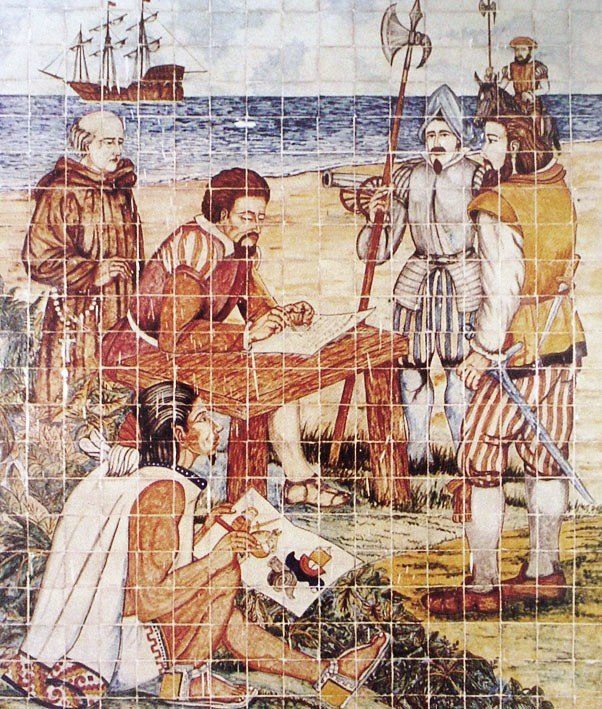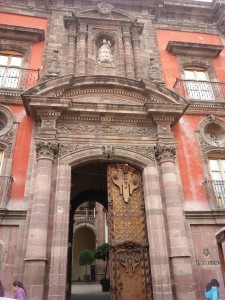My friend Eduardo has inspired me again, this time to compare two leaders—Hernán Cortéz and George Washington, perhaps an unlikely pairing.
Eduardo is currently reading Bernal Díaz del Castillo’s history of the conquest of Mexico. Titled Historia Verdadera de la conquista de la Nueva España (The True History of the Conquest of New Spain), this book is by Bernal Díaz, one of the foot soldiers of Hernán Cortés who was involved in the conquest of the Mexica and the Aztec Kingdoms.
George Washington provided an apt comparison. Last week I spoke about Gálvez to a Remote Production Class, hoping to inspire them to come film the symposium. I was a little more successful than I planned, and wound up with five students and three cameras. One of the students, however, complained that Washington had done “nothing” in comparison to Gálvez’s many successes against the British. “Not so,” I countered.
 I’ve written about Cortéz before ( https://www.carolinacastillocrimm.com/tidbits-from-history-the-spanish-in-mexico/ ). With a group of about 500 men, Cortéz landed on the Mexican coast at a town he labeled La Villa Rica de la Veracruz – The Rich City of the True Cross. No, he didn’t burn his ships to force his men inland but he did strip his ships to build a fort on the coast for protection.
I’ve written about Cortéz before ( https://www.carolinacastillocrimm.com/tidbits-from-history-the-spanish-in-mexico/ ). With a group of about 500 men, Cortéz landed on the Mexican coast at a town he labeled La Villa Rica de la Veracruz – The Rich City of the True Cross. No, he didn’t burn his ships to force his men inland but he did strip his ships to build a fort on the coast for protection.
Then, by the powers of persuasion alone, he led his small troop inland. Into the unknown, attacked and constantly threatened by locals, suffering daily to survive, they followed him to the mighty city of Tenochtitlán. And they defeated the Aztec empire with its standing army of 100,000 men and a city of a million people. It took Cortéz two years and the support of the Aztec’s Tlaxcalteca enemies, but he brought down the great Mexica empire. He went on to become a success as the Count of Oaxaca.
 And then there is George Washington. I have at hand a book titled Almost a Miracle: The American Victory in the War of Independence by John Ferling. At 575 pages and another hundred or so of endnotes and bibliography, it is not an easy read. But it is certainly well worth it to understand what Washington went through to win a victory against the British. (Arnold Freiberg’s The Prayer at Valley Forge.)
And then there is George Washington. I have at hand a book titled Almost a Miracle: The American Victory in the War of Independence by John Ferling. At 575 pages and another hundred or so of endnotes and bibliography, it is not an easy read. But it is certainly well worth it to understand what Washington went through to win a victory against the British. (Arnold Freiberg’s The Prayer at Valley Forge.)
Unlike most of the flag-waving histories of the revolution, Ferling delves deeply into the leaders and their backgrounds. He studies their personalities, what made them successful, and why they had a willingness to take the risks necessary to win—and sometimes lose—battles. Washington’s eventual victory was, without doubt, “almost a miracle.”
As Stanley Weintraub comments, “. . . an often outgeneraled George Washington who, despite an undependable army and a bankrupt Congress, was unexpectedly fortunate in his allies—the revengeful French (Weintraub fails completely to mention Gálvez and the Spanish), ‘mishandled’ Loyalists, irreversible British attrition, and the broad Atlantic.”
 It was Washington’s ability to convince his men, however, again and again, to stay and fight that eventually won the war. Against a vastly superior force, by persuasion alone, when he had no money to pay them, when his men were freezing at Valley Forge, when he fled the British to keep his small army together, he convinced his men to fight. He kept them going, week after week, month after month, year after year. In the end, he brought General Cornwallis and the British to their knees.
It was Washington’s ability to convince his men, however, again and again, to stay and fight that eventually won the war. Against a vastly superior force, by persuasion alone, when he had no money to pay them, when his men were freezing at Valley Forge, when he fled the British to keep his small army together, he convinced his men to fight. He kept them going, week after week, month after month, year after year. In the end, he brought General Cornwallis and the British to their knees.
Both Cortéz and Washington led incredibly small armies against overwhelming odds. Admittedly, both did it by having powerful allies. But they succeeded in defeating their opponents not by being arrogant blowhards or aggressive bullies. They did it by quiet persuasion, by suffering with their men, by keeping up the morale of their troops, by empowering their men with faith that they could win. They had confidence in themselves and their cause. They maintained a commitment to a goal and they did not give up. And they won.
These are the kind of men that are leaders. Would that the current crop of would-be leaders were willing to learn from history.


… [Trackback]
[…] Find More Information here to that Topic: carolinacastillocrimm.com/tidbits-of-history-a-comparison-of-two-leaders/ […]
… [Trackback]
[…] Find More here to that Topic: carolinacastillocrimm.com/tidbits-of-history-a-comparison-of-two-leaders/ […]
… [Trackback]
[…] There you will find 93805 additional Information to that Topic: carolinacastillocrimm.com/tidbits-of-history-a-comparison-of-two-leaders/ […]
… [Trackback]
[…] Find More Info here to that Topic: carolinacastillocrimm.com/tidbits-of-history-a-comparison-of-two-leaders/ […]
… [Trackback]
[…] Information on that Topic: carolinacastillocrimm.com/tidbits-of-history-a-comparison-of-two-leaders/ […]
… [Trackback]
[…] Find More here on that Topic: carolinacastillocrimm.com/tidbits-of-history-a-comparison-of-two-leaders/ […]
… [Trackback]
[…] There you will find 6277 more Information to that Topic: carolinacastillocrimm.com/tidbits-of-history-a-comparison-of-two-leaders/ […]
… [Trackback]
[…] Find More on that Topic: carolinacastillocrimm.com/tidbits-of-history-a-comparison-of-two-leaders/ […]
… [Trackback]
[…] Read More to that Topic: carolinacastillocrimm.com/tidbits-of-history-a-comparison-of-two-leaders/ […]
… [Trackback]
[…] Here you can find 79380 additional Info on that Topic: carolinacastillocrimm.com/tidbits-of-history-a-comparison-of-two-leaders/ […]
… [Trackback]
[…] Find More Information here to that Topic: carolinacastillocrimm.com/tidbits-of-history-a-comparison-of-two-leaders/ […]
… [Trackback]
[…] Read More to that Topic: carolinacastillocrimm.com/tidbits-of-history-a-comparison-of-two-leaders/ […]
… [Trackback]
[…] Read More here on that Topic: carolinacastillocrimm.com/tidbits-of-history-a-comparison-of-two-leaders/ […]
… [Trackback]
[…] Find More Information here on that Topic: carolinacastillocrimm.com/tidbits-of-history-a-comparison-of-two-leaders/ […]
… [Trackback]
[…] Find More on that Topic: carolinacastillocrimm.com/tidbits-of-history-a-comparison-of-two-leaders/ […]
… [Trackback]
[…] Information on that Topic: carolinacastillocrimm.com/tidbits-of-history-a-comparison-of-two-leaders/ […]
… [Trackback]
[…] Here you can find 73522 additional Info on that Topic: carolinacastillocrimm.com/tidbits-of-history-a-comparison-of-two-leaders/ […]
… [Trackback]
[…] Info to that Topic: carolinacastillocrimm.com/tidbits-of-history-a-comparison-of-two-leaders/ […]
… [Trackback]
[…] Information on that Topic: carolinacastillocrimm.com/tidbits-of-history-a-comparison-of-two-leaders/ […]
… [Trackback]
[…] Here you will find 66945 more Information to that Topic: carolinacastillocrimm.com/tidbits-of-history-a-comparison-of-two-leaders/ […]
… [Trackback]
[…] Here you will find 78858 additional Info on that Topic: carolinacastillocrimm.com/tidbits-of-history-a-comparison-of-two-leaders/ […]
… [Trackback]
[…] Find More Information here on that Topic: carolinacastillocrimm.com/tidbits-of-history-a-comparison-of-two-leaders/ […]
… [Trackback]
[…] Find More Information here on that Topic: carolinacastillocrimm.com/tidbits-of-history-a-comparison-of-two-leaders/ […]
… [Trackback]
[…] Here you can find 79060 additional Info to that Topic: carolinacastillocrimm.com/tidbits-of-history-a-comparison-of-two-leaders/ […]